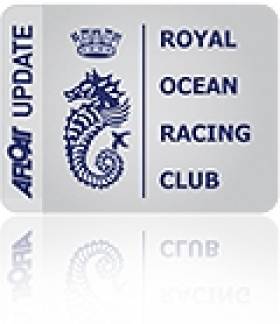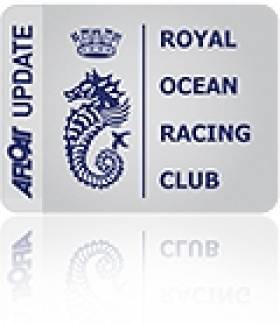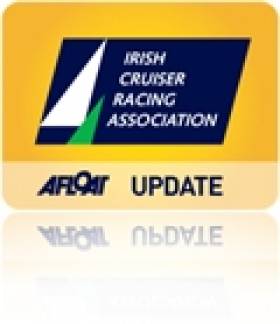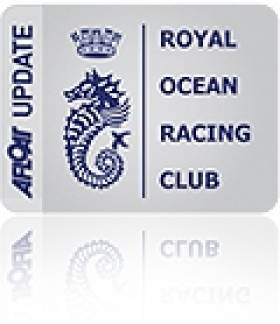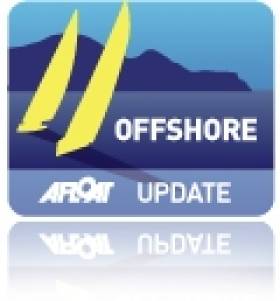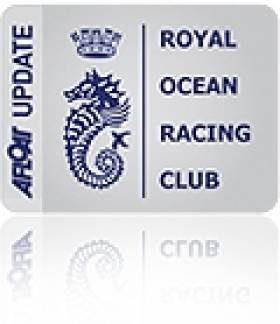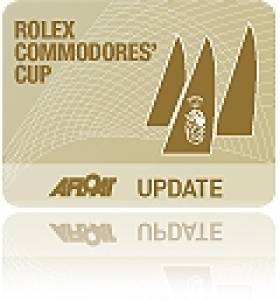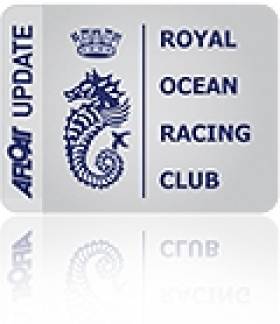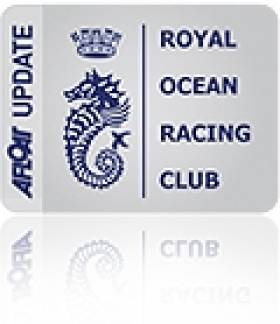Displaying items by tag: RORC
Cork, Howth and Dun Laoghaire Boats Fly the Flag in Cowes
#OFFSHORE – Solent winds finally came good for the last day of the Royal Ocean Racing Club's (RORC's) Easter Sailing Challenge on Easter Sunday with Irish boats from Royal Cork YC , Howth YC and Royal Irish YC, Dun Laoghaire finishing second third and fourth in class respectively.
Anthony O'Leary was second in IRC one sailing Antix with 15 entries, Dave Cullen's Half Tonner King One was third sailing in IRC IV class B with seven entries and Niall Dowling's brand new J111 Jazzband was fourth sailing in Class II with 10 entries.
With the wind backing into the south and building to double figures. To make up for yesterday's lack of wind, three races were held for all classes.
Runaway winner in IRC One was South African Michael Bartholomew and his well honed crew on the Hamble-based King 40 Tokoloshe. A 5-1-5 scoreline today saw them conclude the regatta with a nine point lead over Irishman Anthony O'Leary's 2010 Commodores' Cup-winning Ker 39, Antix. Tokoloshe is touted as a Cork Week front runner this July so there will be at least one rematch for the Antix crew on home waters this season.
Simon Henning's Farr 45 Alice was doing well, but was let down by a 13th place in today's second race causing them to drop to third overall, just two points ahead of the British Keelboat Academy on their Niklas Zennstrom-owned sistership Kolga. The Ker 40 dust-up was close with Jonathan Goring's Keronimo finishing two and half points ahead of Andrew Pearce's newer Magnum III.
Despite a strong final push by Jackie Dobson and the crew of the J/133 Jeronimo winning today's two final races, Jim Macgregor and his Poole-based Elan 410 Premier Flair maintained their lead in IRC Two to win by three points. Andrew McIrvine, ex-Commodore of the RORC, came into his own today with his First 40 La Réponse finishing third in each race today.
"It was nice to have the breeze, although we didn't change gears that well," admitted Macgregor. "In the light wind this morning - we had that sussed and we got a win. We had not a bad second race, but we weren't properly set up for the third. There were lots of boats going around corners at the same time, but everyone was well behaved. It was a very enjoyable event and we are very grateful to the RORC and Eddie Warden Owen."
Of Jeronimo's late charge, Macgregor said: "She is going really well. It was tough when she ran aground on Friday. The plateau there did seem to be getting shallower. Perhaps it's the high pressure."
In IRC Three competition was tight. The outstanding performance today was that of David Franks and his new JPK 1010 Strait Dealer, which posted three bullets in as many races. Unfortunately after a slow start to the regatta this was not enough for them to catch David Aisher's British Keelboat Academy crewed J/109 Yeoman of Wight, which was top of the seven J/109s but one point shy of Peter Morton's MAT 1010 in the overall points.
"We loved it, we had a really good time. It was really nice to be back on the water," said MAT 1010's Louise Morton, making her return to competitive yachting for the first time since breaking her leg last June. On MAT 1010, today's races were steered by ex-British Keelboat Academy members Colette Blair and Mark Lees, the competitive juices flowing to ensure they finished ahead of their former colleagues on Yeoman of Wight.
After today's three races there was a leader change in IRC4A with father and son, Mike and Jamie Holmes and their J/97 Jika Jika overhauling sistership, Grant Gordon's Fever, to win by just two points.
"It was our first time out this season, so it took a while for us to blow away the cobwebs," admitted Jamie Holmes. "We led Fever during the race the day before a couple of times, but we threw it away through kedging badly!" Of today's race management on their course despite the powerful spring tide, Holmes added: "They did really well to get three fair races off, particularly after yesterday being so challenging. The tide was more of an issue yesterday, going backwards, than it was today."
According to Mike Holmes, their win came as a surprise as they hadn't expected three races to be held today - one more than scheduled.
IRC 4B was dominated by the Half Tonners, but by one in particular - the 1985 vintage MG30 Checkmate XV, skippered by Nigel Biggs - which completed the RORC Easter Challengewith a perfect scoreline.
"It was beginner's luck," said Biggs. "We only bought the boat a couple of months ago and it has had a massive refit at Corby's. We were working all hours over the last month to get it built. In fact on Friday morning it was a good job there was a postponement, because we were still drilling through the deck to put the deck gear on..."
"We have had some people with us," said Biggs of how they had done so well. "David Howlett [Ben Ainslie's coach] has been helping us a lot and John Corby and Mark Mills has done some design work on the boat. So a lot of thought has gone into it and as a group our Checkmate sailing team has been together for 15 years."
Biggs added that today was the first time they have sailed with the boat fully loaded up. "We were looking around to see what was going to blow up, but nothing did."
A worthy third was David Cullen's Irish team on King One, Paul Elvstrom's Half Ton Cup winner from 1980. "We got two 4s and a 3. That's two 4 o'clock in the mornings and a 3 o'clock...and our results reflected that," quipped Cullen, whose boat has remained in Cowes since the Half Ton Classics Cup last year when she broke her rig.
With a near perfect scoreline was Robert Larke in the J/80 one design class, dropping yesterday's one race to the Rachel Woods-steered Jumblesail. While Larke posted three bullets in today's races in the Northern Solent, so consistently second was William Goldsmith's Slam-sponsored team on Exess.
"Yesterday was frustrating to say the least," said Goldsmith. "Today it was a day of no mistakes or fewer mistakes. We struggled with starting earlier on in the week, but finished with a very good start and rather than J2X being off on their own, today we were keeping up with them and it was us and them and the rest of the fleet behind."
Goldsmith is with the British Keelboat Academy and is gunning with his team - average age 20 - for a good position in the J/80 Worlds to be held in Dartmouth later this year. "They will be huge and we want to try and stay up with the top of the fleet there. With the Worlds coming up its in our best interest to have all the British boats work together and that is part of the RORC Easter Challenge to get everyone coached."
At the prizegiving held in the Cowes Yacht Haven Events Centre, Commodore of the RORC Mike Greville thanked the race officials before Easter eggs were handed out as prizes to all of the winners.
All Eyes on New Boats for RORC's Season Opener
62 boats are entered with the fleet split into IRC classes 1-4 with a separate class for the J/80s.
The forecast shows the wind mostly to be under 10 knots for duration of the event, but gusty and with significant shifts occurring over the three days: the wind easterly, but backing into the NNW tomorrow, returning to the east on Saturday before backing into the northwest again and dropping on Sunday.
This being the RORC's UK season opener, so all eyes will be on the new boats out on the race course. Among these is a boat expected to deliver a significant punch in IRC Three: David Franks' latest Strait Dealer. Based in Malta and for many years a regular in the Rolex Middle Sea Race, Franks moved back to the UK last year, selling his J/125. Over the winter he acquired a JPK 1010. This French 33 footer is the first of its kind in the UK, but left a lasting impression when sisterships Foggy Dew and Wasabi demolished the opposition in IRC Three of the Rolex Fastnet Race last year. The new Strait Dealer's first outing was two weeks ago when they won their class in the Warsash Spring Series.
So the RORC Easter Challenge will be a good warm-up for the Strait Dealer crew: "We are in class 3 and we are pretty much the lowest rated boat in that class, which isn't a good thing," says Graham Sunderland, who runs the campaign for David Franks. "But as Rob Greenhalgh, once said: 'This is a practice event, so let's practice winning!'"
Unfortunately the forecast isn't ideal for Strait Dealer. "All these boats have their zones and the weak spot for our boat is sub-10 knots," admits Sunderland. "But equally, so was the Spring Series and we nailed that. So we'll see how we go."
In IRC One, a full-on match race is expected between the two Ker 40s, Jonathan Goring's Keromino and Andrew Pearce's Magnum III, the latter brand new.
Andrew Pearce says the significant coaching aspect of the RORC Easter Challenge will be an extension of the Magnum team's training program. "I have always used Jim Saltonstall as our own personal trainer and mentor anyway," says Pearce. "Whenever we do a Commodores' Cup campaign - which was 2004 and 2008, and now 2012 - I bring Jim on to the team, so we have been training with him for some weeks and the RORC Easter Regatta is like a continuation of that."
Jim Saltonstall, the regular coach at the RORC Easter Challenge, is away on holiday at present, so the coaching at the RORC Easter Challenge is being run by the highly experienced Barry Dunning.
Having carried out some two boat testing against Keronimo, Pearce is also looking forward to lining up against the rest of the IRC One opposition, including the King 40s Tokoloshe and Cobra.
Cobra (ex-Argie Bargie) was acquired just before Christmas by father and son Mike and Seb Blair, who previously campaigned the Ker 11.3, Skipjack. Like many of the boats taking part at the RORC Easter Challenge, the Cobra crew is using the event as a warm-up for the British trials for the Brewin Dolphin Commodores' Cup.
"Even though this isn't our trials selection it is almost our Commodores' Cup crew," says Freddie Hall, who runs the campaign for the Blairs. Helmsman on board is Hall's father-in-law, Chris Warnsley.
Looking forward to this weekend's regatta, Hall says: "It is a very challenging fleet. There are no bad boats there. It is going to be a chance for us to see where we are against the competition. The competition at the Easter regatta is going to be as hot as other regattas this season, especially with two new Ker 40s."
A unique feature of the RORC Easter Challenge is the on the water and shore-based coaching and Hall agrees that they will find this useful to ensure they have the set-up correct on their new boat. "The team has sailed together for many years now, so hopefully we have a running start on manoeuvres."
Racing is due to get underway at 1300 tomorrow, but before this, from 1100, lines will be set allowing teams to try some practice starts.
Boats Line Up for British Trials But Irish Commodore's Cup Team Still Eagerly Awaited
While the Royal Ocean Racing Club (RORC) are reporting a near record turn-out for the British trials for July's Commodores' Cup there is still no update on an Irish team to defend the title it won in 2010.
The RORC more open rating bands for the 2012 Brewin Dolphin Commodores' Cup are having the desired effect: As the deadline closed for teams wishing to enter the British trials for this July's Cowes-based event, so 17 boats had registered - a near record compared to past trials.
Although Ireland is officially slated by the Royal Ocean Racing Club to be defending its 2010 title won on the Solent there is still no details of the compostion of an Irish team for July's Commdore's Cup.
Ireland face an uphill struggle to mount a credible defence, though Antony O'Leary's Antix is most likely to be a key part of any team, which is a major asset, there is still the job of completing the three boat line-up. A call to interested parties was made late last year by the Irish Cruiser Racing Association (ICRA).
ICRA Commodore Barry Rose says that despite the current difficult environment ICRA remains hopeful of mounting a serious defence and have waited until last October to allow the maximum time to those who may consider supporting the challenge but since then there has been no further news of the team.
In addition to his important role as Chairman of the Royal Yachting Association, Stacey Clark is also Chairman of the Selectors for the British Brewin Dolphin Commodores' Cup team, a panel he sits on with professional sailor, Chris Mason, now Yachting Secretary of the Royal Yacht Squadron, and Cowes Week CEO, Stuart Quarrie.
Clark himself has been helmsman on the various Cutting Edge campaigns, including most recently a Farr 45 and a TP52. "I think given the world the way it is at the moment, we are pretty pleased," he says of the turn-out. "We have a healthy number of trialists and we are optimistic about being able to put forward very strong teams."
While 17 boats are entered in the trials, still unresolved is the number that will make it through, as the GBR selectors have yet to decide whether they will enter three or four teams (each comprising three boats). Clark says that originally the fourth had been allocated to go to a team from the north of England/Scotland, but this hasn't materialised. "We have the option to go to four teams, but we have decided that we'd like to see the trials before deciding whether to enter three or four. We want to enter teams that will do credit to the GBR name in this regatta, as well as look to build for the future."
This year the selection is focussing on the performance of the 17 boats at two events: the RORC's Morgan Cup offshore starting on 5th May and the Royal Corinthian YC's Vice-Admiral's Cup inshore series over 18-20th May. The latter will feature a 'Commodores' Cup class'. "With the wide rating band, these boats don't usually race each other on the same start line, on the same course, at the same time," explains Clark.
As to why so many boats have entered the trials in these austere times, one reason is certainly the RORC's amendment to the rating bands. For this year's Brewin Dolphin Commodores' Cup there is effectively one large rating band, with eligible boats required to have an IRC time correction co-efficient (TCC) of 1.020-1.230. Among each three boat team only one can be a 'big boat' (ie with a TCC of 1.150-1.230), so a team could field a team with no 'big boat'.
Clark believes this has opened up the competition, making it more even across all of the trialists. "Last time around there was strong competition for some of the smaller boat slots, but it was hard to find the right big boat," he says.
As present the British contenders include three Brewin Dolphin Commodores' Cup 'big boats' - the two Ker 40s, Jonathan Goring's Keronimo and Andrew Pearce's Magnum III, and Ian Blair's King 40, Cobra.
Several others are repeat customers from the 2010 British team. Former Commodore of the RORC, Andrew McIrvine is back with his First 40, La Réponse, while his co-2010 co-skipper Peter Morton has entered his own recently acquired Corby 33, Salvo. Steven and Jane Anderson are back, but on a different boat having bought the well known Corby 40, Cracklin Rosie, which Brian Wilkinson campaigned two years ago.
For Andrew Pearce this will be his third Commodores' Cup having previously competed in 2004 and 2008. This year he is greatly looking forward to campaigning his new Ker 40, one of three likely to be taking part, including Keronimo and another in the Hong Kong team.
"These boats are so unbelievably well matched," says Pearce, whose new Magnum III was delivered just before Christmas, replacing his previous IMX40. "We've been racing against Keronimo and they are just so even out on the water - it's very exciting racing. And the boat is awesome. Even in 10 knots, you get the kite up and get the boat well heeled, and you are doing 8-9 knots. Already we've had the boat doing 18 knots in flat water and we are going to get over 20 knots."
As to the trials this year, Pearce says it will be interesting because with the new rating band, the selectors have a more open hand. "When we have done it in previous times, generally we have been in what has been colloquially called 'the heavy weather team'. The IMX 40 I took down the non-overlapping route, so we were set up for stronger winds - 15 knots and above we were unbeatable, a real bandit, but below that it was a bit tricky. Now they can't end up with three Ker 40s, because there is a limit to the boats above 1.150, but they could end up with a team of three J/109s, if they felt that type of boat might have a niche in the weather patterns where they are going to excel. So it is a very different set-up this time around."
Like the selectors in previous years, Stacey Clark won't elaborate on how they will divide up the teams this time.
As to the competition in this year's Brewin Dolphin Commodores' Cup, Pearce concludes: "They have got the right level. I think it is going to be a brilliant Commodores' Cup. There has been a good level of interest from abroad, so I think it will be a very successful regatta.
Dun Laoghaire's Niall Dowling, who finished runner up in the Royal Ocean Racing Club's (RORC) 2011 overall IRC Championship, has replaced his J/111 with another, his new boat is called Jazzband. The boat has only recently reached the UK and the RORC Easter Challenge will be the boat's first outing.
"I was originally going to be getting one in the States and the plan was to do the RORC 600, but work-wise I am stuck in European ground," says Dowling, of why he's changed boats.
Dowling says that he is planning more of an inshore campaign this year with Jazzband, but is contemplating taking on the Round Ireland Race doubehanded, which he sailed four years ago on a J/105.
The RORC Easter Challenge, due to take place on the Solent over the first three days of the Easter Bank Holiday (6th-8th April), will offer crews a unique opportunity to jump start their sailing programmes.
As well as being the first fixture in the RORC's UK racing calendar, the RORC Easter Challenge doubles as a start of season training event, with on the water coaches providing immediate advice followed by expert post-race video debriefs in the Events Centre in Cowes Yacht Haven. In fact the coaching element of the regatta is taken so seriously that the Racing Rules of Sailing are modified for the event permitting coaches or sailmakers to climb on board during racing if, for example, a crew requests some expert assistance with their sail trim or rig set-up.
The coaching this year is being spearheaded by Barry Dunning, who points out that while owners typically spend considerable sums on gear for their boats, coaching is a feature of their campaigns often overlooked. "If they just spent some money and some time on coaching, they would be up the fleet by miles," he advises. Of course at the RORC Easter Challenge it is laid on for free.
Of the coaching due to take place at this year's event, Dunning continues: "We are going to do exactly the same format as previous years: ie do our coaching out on the water, come back and then do a debrief, with video of the starting and answering any questions. And we will do that each day."
Dun Laoghaire's Dowling says: "I find the coaching is very good, once you get used to being called a ferret by Jim Saltonstall! They and the sailmakers were brilliant jumping on and off the boat, and it was a good time to do it at the start of the season to set up everything. For us as a first sail and a first race it is great and all the video footage and so on, it is live without being too intense."
This year there will be one new feature to the coaching. With the start of racing on the Friday scheduled for 1300, so, from 1100, lines will be set up allowing participants to carry out practice starts.
But it is the on-the-water coaching that is really unique. Not only can coaches climb on board boats, but any crewmembers competing are also allowed to step on to the coach boats to see how their yacht's trim and set-up looks from off their boat and can even do this mid-race if they so desire - a opportunity rarely allowed in other events.
"I want to make sure that people use us," adds Dunning. "They can call on any of the coach boats to come and help them. So give us a wave and we'll be there with you."
Among the competitors a strong line-up is expected at the RORC Easter Challenge with 10 boats already entered in Class 1, ranging from the largest and fastest, Piet Vroon's 2010 RORC Boat of the Year-winning Ker 46, Tonnerre de Breskens, to Stephen Anderson's perennial Cracklin Rosie, the Corby 40. Also entered in Class 1 to date are three Farr 45s and Andrew Pearce's new Ker 40, Magnum III.
Many teams - including both Magnum III and Cracklin Rosie - are using the RORC Easter Challenge as an opportunity to get up to speed before the trials to earn a place in one of the four British teams for July's Brewin Dolphin Commodores' Cup. Managed by the RYA these trials start on 5 May with the RORC's Morgan Cup.
In Class 2, another triallist taking part in the RORC Easter Challenge is Jim Macgregor's Poole-based team on his Elan 410 Premier Flair. "I seem to spend half of my life helping girls get coached at the club, so I am very much in favour it, but I just don't apply it to myself!" says Macgregor whose two daughters, Lucy and Kate, will be representing Britain at the Olympic Games in the women's match racing.
"For people like us who have sailed a lot, when you own your own boat you don't go on other people's boats so you don't improve as much as you might. So it is a great opportunity to use the coaches and it is enjoyable as well."
Several new J/109 teams will also be taking part. From Brighton Robert Stiles will be campaigning Diamond Jem and is another gunning for Team GBR Brewin Dolphin Commodores' Cup selection, while for Jonathan Bevan's Jelenko it will be his first time at the RORC Easter Challenge. Having campaigned Richard Tolkien's Class 40, Tom Hayhoe has his new J/105 Mostly Harmless entered.
In addition to the four IRC classes, the RORC Easter Challenge will also feature a separate class for J/80s. With the J/80 Worlds due to take place in Dartmouth in June, the RORC Easter Challenge is an ideal opportunity for teams to get some free training in as they work towards this all-important event for the class.
Aside from being the first RORC race of the year in the UK, plus the coaching opportunity, the long range forecast is also suggesting sun and a light to moderate breeze, so the RORC Easter Challenge is lining up to be a perfect way to ease into the sailing season.
Four Irish On World's Largest Carbon Yacht for Caribbean 600
#CARIBBEAN 600 – A plan to secure line honours at the Caribbean 600 race on the world's largest carbon composite sailing yacht includes four Irish sailors on the 29–man crew. The Royal Ocean Racing Club race route circumnavigates 11 Carribbean islands and begins on February 20th.
The crew on the 200 foot long yacht is composed of many Volvo ocean race and Americas cup veterans and also includes Irish sailors James Caroll, Johnny Mordant, Aaron O'Grady and Mark O'Reilly.
The 67–metre yacht Hetairos was launched on June 2011 in Finland and last year the massive entry won line honours and finished second overall in the IMA Superyacht transatlantic race between Tenerife and the BVIs.
Hetairos is 200 feet long and carries up to 4400 Square metres of sail area.
With less than one month to go, to the fourth edition of the RORC Caribbean 600, the Royal Ocean Racing Club's 2012 programme kicks off with a sensational cast in Antigua.
The RORC Caribbean 600 is a truly international affair, with well over 500 hundred competitors from at least 24 different nations taking part. More than 30 impressive yachts are expected to take part in a high-speed, action-packed yacht race around 11 Caribbean islands. There can be few sporting events that can boast such a worldwide appeal with sailors taking part from all over the world including: Antigua, Australia, Austria, Canada, Cayman Islands, Croatia, France, Germany, Great Britain, Holland, Ireland, Italy, Japan, Malta, New Zealand, Norway, Puerto Rico, Russia, South Africa, Spain, Sweden, St. Lucia, Trinidad & Tobago, Turkey and the United States of America.

The largest yacht in the Caribbean 600 fleet will have four Irish sailors onboard: The magnificent 67m Hetairos. Credit:Hetairos/Baltic Yachts
This astounding diversity of nationalities is matched only by the astonishing array of yachts and personalities. The largest yacht competing this year is the magnificent Hetairos with a waterline length of 200'. Hetairos is the world's largest carbon composite sailing yacht. The 29 crew on board is composed of many Volvo Ocean Race, America's Cup and Jules Verne around the world veterans. Hetairos is among the favourites to take line honours, but there are several other yachts more than capable of finishing in front.
In 2011 American George David skippered Rambler 100 to smash the monohull course record, taking line honours and overall victory. David's team is back, this time with the Reichel Pugh 90, Rambler and they are unlikely to give up the title without a fight. The Spanish Volvo 70, Gran Jotti will be dwarfed by Hetairos, but the former Telefonica Black has a venomous turn of speed and is quite capable of out pacing the entire fleet. On board there is a huge wealth of talent in the form of Spanish America's Cup and Volvo Ocean Race sailors. These three are likely to be contenders for line honours, but overall victory under IRC is far more difficult to predict. A hot contender is Niklas Zennstrom's Judel/Vrolijk 72 Rán, which will be making its debut in the RORC Caribbean 600.
"For me it's very refreshing to tackle a new race and the Caribbean 600 is a real fascination," explained Hayles. "It's unlike any other offshore race in that the average leg is only about 40 miles and for a navigator there is a lot to consider. Normally, a race is all about the weather and strategy but in addition to all that, this race takes you back to the basic problem of navigating around so many rocks and islands. Looking through all the legs, there is a broad mixture of sailing angles; there is a fair bit of reaching, but it is wrong to think that is not a challenge, especially with the speed sensitivity of modern high-performance boats. The course is more like a whole stream of complex coastal races. I have to say that it is a pretty unique race."
A dazzling variety of yachts crewed by some of the world's finest will be racing this year. However, not all of the competitors are seasoned professionals. One of the smallest yachts competing this year is J/39 Sleeper, which will be raced two-handed by a father and son team. Jonty Layfield and son Jack are both RORC members and hale from Brighton, UK. Last year with a full crew, Jonty's won class at Antigua Sailing Week:
"Sailing Two-Handed with my son, I don't expect to be very competitive, we are not going to go flat out but treat the race more like a delivery trip," admitted Jonty. "I have raced double-handed with my son back in England and I have been sailing with Jack since he was about five years old, we are more like friends than father and son. The great thing about sailing is that you have to get on with it; you can't have any histrionics. Jack is working in Brazil at the moment and the RORC Caribbean 600 is a great way to spend a few days together."
Close duels are expected right through the fleet, none more so than in the Class 40s where a hard fought and close encounter is expected. Tradewind sailing provides perfect conditions for Class 40s, with long reaches and downwind legs, these pocket rockets are capable of surfing at speeds of up to 25 knots. Peter Harding's 40 Degrees has Hannah Jenner as skipper, the only female to skipper the Clipper Round the World Race. Hannah was in fine form last year, gaining a podium position in the Class 40 Transat Jacques Vabre:
"Antigua is a beautiful place to start the season with some winter sunshine and I have heard that Antigua Yacht Club provides a great party!" smiled Hannah. " The race course has plenty of activity with sail changes and the competition should be really close. Making the right tactical decisions will also be very important if we are to be the fastest Class 40 around the track. I am really looking forward to the race."
Hannah Jenner on Peter Harding's 40 Degrees in the 2011 Transat Jacque Vabre/ Credit: Alexis Courcoux
RORC Chief Executive Eddie Warden Owen believes that the RORC Caribbean 600 is especially attractive to larger yachts, however the ethos of the club maintains equal status to every participant.
"A wide spectrum of yachts and competitors has decided that this is an event that is not to be missed. The club is delighted that people from all over the world want to take part. There is a mixture of world class sailors and corinthian enthusiasts, but they all have one thing in common, a passion for offshore racing."
"This average length of yacht for this year's entry is over 70'. When the Royal Ocean Racing Club started this race in 2009, we felt it would appeal to larger yachts and that has proved to be the case. This year we have a significant number of Racing Maxis, Super Yachts and Spirit of Tradition yachts. However, every yacht competing in the RORC Caribbean 600 is governed by the same set of rules. All of the competitors receive a warm welcome from the Antigua Yacht Club, regardless of their finish time or place. Since 1925, The Royal Ocean Racing Club has promoted offshore racing for all and in many ways the RORC Caribbean 600 typifies that cause."
The 2012 edition of the RORC Caribbean 600, organised by the Royal Ocean Racing Club and hosted by the Antigua Yacht Club, will start on Monday 20th February 2012.
Past Results:
RORC CARIBBEAN 600 TROPHY - IRC OVERALL
2011 - George David, Rambler 100, JK 100 (USA)
2010 - Karl C L Kwok, Beau Geste, Farr 80 (HKG)
2009 - Adrian Lee, Lee Overlay Partners, Cookson 50 (IRL)
Records:
Multihull record holder - Region Guadeloupe in 40 hours 11 mins 5 secs (2009)
Monohull record held by Rambler 100 in 40 hours 20 mins 02 secs (2011)
Royal Irish Yacht Arabella Takes Three RORC Awards
The Royal Ocean Racing Club in London has awarded Niall Dowling's Royal Irish yacht Arabella (a J111) the Alan Paul Trophy for consistent high performance in IRC, the Serendip Trophy for best series-produced Yacht in IRC, and the second place medallion in IRC overall for the 2011 RORC season.
Ireland Thankful to Escape Favourites Tag for Commodore's Cup 2012
Ireland's 2010 Commodore's Cup winning captain showed his relief at the news that Hong Kong have been tipped as favourites for next July's event, The Irish Times reports.
The announcement was made this week at the Royal Ocean Racing Club (RORC) in London, and should lift a burden off an Irish squad which has long suffered under the weight of being pre-event favourites.
Ireland's concerns instead have turned to whether a team can even be assembled for next summer's event in light of the difficult economic environment - and despite the RORC opening the rating bands to allow for more flexible combinations of boat sizes.
As previously reported on Afloat.ie, the Irish Cruiser Racing Association (ICRA) is seeking expressions of interest to form an Irish team and remains hopeful of mounting a serious defence of the title won by last year's Anthony O’Leary-captained squad.
The next Commodore's Cup - which also has a new title sponsor in Brewin Dolphin - takes place from 21 to 28 July 2012 in Cowes.
Offshore in the Caribbean as a Round Ireland Warm Up?
Is there any way you could get away with saying that a sailing race in the Carribbean this winter is essential training for next June's Round Ireland Race? As unlikely a story as it may sound the warm water series is in fact gaining ground as a 'must do' event on the offshore calendar.
Of course the Carribbean regatta and our own 700-miler are both Royal Ocean Racing Club fixtures but for many of us that's as close as the connection may ever come but for those considering winter sunshine here's the details:
The RORC Caribbean 600, run by the Royal Ocean Racing Club in association with Antigua Yacht Club, is the only offshore race of the Caribbean series and since its conception in 2009, has become a firm favourite with offshore racers seeking a tactical challenge in warm Caribbean conditions. The 2012 edition will witness an impressive line-up of yachts starting from Antigua on Monday 20th February.
The fleet will battle the 600nm course which circumnavigates 11 Caribbean Islands starting from Fort Charlotte, English Harbour, Antigua and heading north as far as St Martin and south to Guadeloupe taking in Barbuda, Nevis, St Kitts, Saba and St Barth's. Perfect racing in perfect conditions.
RORC Commodore, Andrew McIrvine will be competing for the second year in the elegant 154.5ft classic schooner, Windrose of Amsterdam:
"The RORC Caribbean 600 is now well established on the international offshore racing calendar. We are excited about the quality of the boats intending to race in 2012 and expect to follow this year's record entries which represented 15 different countries. The race has great appeal to offshore sailors as it's a modern race in every sense; the course is designed to provide an exciting and inspiring race that compliments modern yacht design. The club is delighted that sailors from all over the world want to take part. The diverse fleet will be a mixture of world class sailors and corinthian enthusiasts, but they all have one thing in common, a passion for offshore racing and a challenge."
Attracting Top Boats
It's the Caribbean sailing conditions that attract highly competitive and successful racing teams such as Niklas Zennstrom's Rán. Their mythological sea goddess in the form of the 72ft Judel/Vrolijk, mini maxi Rán, are hoping to add to their silverware collection following overall wins in the Rolex Fastnet Race and Mini Maxi Rolex World Championship this year and Team Manager, Tim Powell explains why:
"The Rán team are looking forward to competing in the 2012 edition of the RORC Caribbean 600 as it's an event we have wanted to race in since its inception due to the fabulous sailing conditions that are the 'norm' in that area. It will be a great race."
Rambler Returns
George David is planning to return to the Caribbean to defend the 2011 title he won in Rambler 100. This time he will be using the water ballasted Reichel/Pugh designed Rambler 90 and this will be the first race the team will have done together since the capsize of Rambler 100 in the Rolex Fastnet Race that sent shivers through the yachting community. It is unlikely that he will be close to beating the race record he set, but he will have a battle on his hands for overall line honours with some of the super yachts that are expected to compete.
Super yachts
Interest has already been received from a diverse range of boats and crews: In the super yacht class - the 38m Philippe Briand designed, P2, skippered by Jonathan Kline and Peter Harrison's Farr 115, Sojana. Peter has been an admirer of the race since its conception and he competed for the first time this year finishing second in IRC Zero and third Overall.
Also planning to compete is the brand new 66.7m (219ft) ketch, Hetairos, built by Baltic Yachts. This incredibly luxurious, fast yacht designed purely for pleasure, will also compete in regattas where competition is fierce. She is currently undergoing sea trials and if all goes well she will be there.
Traditional
In the Spirit of Tradition class, the 180ft (55m) classic twin-masted schooner Adela will line up against the 155ft Windrose of Amsterdam whose classic hull and modern schooner rig was conceived to win races of this type.
Other Entries
Other interesting entries include: Brad Van Liew's Le Pingouin, winner of the 2010/11 Velux 5 Oceans. Charleston-based Brad sailed the Open 60 to victory in the race around the world, winning every ocean sprint of the 30,000 mile race and becoming the first American to ever officially complete three solo races around the globe.
Also intending to compete: Idea, the Reichel Pugh-designed 78ft maxi, Peter Aschenbrenner's 63ft trimaran Paradox, Amanda Hartley's Swan 56 Clem, Christian and Lucy Reynolds Swan 51, Northern Child and the Swan 48, Scarlet Oyster. Ondeck will enter Farr 65s and a Beneteau 40.7, First 40 and Santa Cruz 37 for charter. The Grand Soleil 46, Belladonna Logic has been entered by Sailing Logic, winners of the RORC 'Sailing School Boat of the Year' for the past six years.
Once again, the RORC Caribbean 600 has seen increased enquiries for the charter of yachts from individuals who wish to enjoy winter sunshine racing in the Caribbean and from companies who are selling places on their yachts. For more information about boats available for charter, check out the race website: http://caribbean600.rorc.org/entries/entries/charter-opportunities.html
Thick Fog, No Wind Present Cherbourg Challenge
The fog also caused the race committee problems at the start and the RIB at the outer distance mark was invaluable in checking for OCS boats. The wind was westerly force 3 and the fleet were just able to carry their kites. Exiting the Solent to the East there were large holes in the wind to spot and avoid off Bembridge.
The light wind prevailed throughout the race and the first boat to finish was the Carroll Marine 60, Venomous, owned by Derek Saunders, which took over 14 hours to complete the 78 nautical mile course to win IRC Zero. Erivale, Mike Greville's Ker 39 took class honours in IRC One and IRC Overall finishing at 1026. David Ballantyne's J/133 Jings took second in both IRC One and IRC Overall finishing at 1057. She was followed by Class 40 winner Marc Lepesqueux sailing Les Conquérants de Normandie at 1134. Then there was a long wait until the rest of the fleet trickled into Cherbourg over the course of the afternoon.
Steven Anderson sailing his 40.7 Encore two-handed claimed a win in IRC Two, with Ed Broadway's First 40 Carpe Diem second and RORC Commodore Andrew McIrvine's La Réponse third.
In IRC Three Nikki Curwen triumphed in her J/105 Voador from sister ship Diablo-J sailed by Rear Commodore Nick Martin. Peter Olden's A35, Solan Goose piped Noel Racine's Foggy Dew to get third place by four minutes on corrected time.
Jean-Yves Chateau's Iromiguy won IRC Four by over two hours from Ian Braham's Enigma. Kirsteen Donaldson sailing her X332 Pyxis, took third place in IRC Four but was delighted to win the Two-Handed Class beating Steven Anderson's Encore by just four and a half minutes. The win meant all the more to Kirsteen after her disappointment at having to retire in the Rolex Fastnet Race with standing rigging failure.
The race proved a suitable end to a challenging Season. The Season's Point's and other Trophy winners will be announced within the next few days.
RORC Season Finale in Cherbourg This Weekend
After a record breaking Rolex Fastnet Race, the final race of the RORC Season's Points Championship takes place this weekend writes Louay Habib. After a scintillating season of racing with the Royal Ocean Racing Club, current weather models pAfter a record breaking Rolex Fastnet Race, the final race of the RORC Season's Points Championship takes place this weekend. After a scintillating season of racing with the Royal Ocean Racing Club, current weather models predict a light airs race, in sharp contrast to a very windy season.
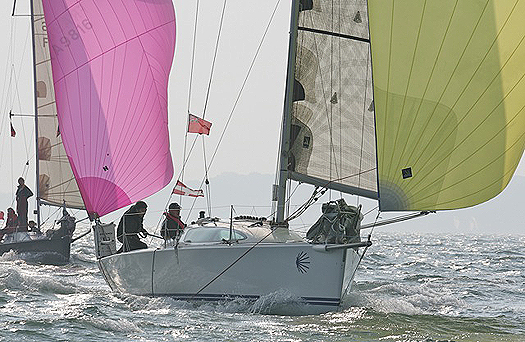
In IRC Zero Derek Saunders' CM 60, Venomous, has already clinched the class title but no doubt the team will be celebrating in style in Cherbourg, as this is their first series win with the yacht after three years of trying.
Piet Vroon's Ker 46, Tonnerre de Breskens, has already wrapped up the class win in IRC One and after competing in nine races this season, the sky blue flyer is sitting out the race to Cherbourg. However, in IRC Two Neil Kipling's J/122, Joopster, needs to get a result against Ross Appleby's Oyster 48, Scarlet Oyster, to be sure of the season win. Neither of these yachts has won their class for the RORC Season's Points Championship before but the conditions and the points favour Joopster to take their first RORC Season's Points Championship win.
Noel Racine's JPK 10.10, Foggy Dew, has an unassailable lead in IRC Three after picking up maximum points in the Rolex Fastnet Race but the team from Le Havre are still competing in the final race of the season.
IRC Four has been incredibly competitive and after a long and exciting season, the class title looks like going to French JPK 9.60, Ultreia!, skippered by Matthias Kracht. However Harry Heijst's S&S 41, Winsome, and Nigel Goodhew's Sigma 38, Persephone of London, are also racing to Cherbourg and will have a close battle for the runner up spot in IRC Four.
Matthias Kracht, skipper of Ultreia!, is a surgeon but he is obviously proficient in mathematics as he explained:
"By my calculations Ultreia! has a good enough points score in the Two-Handed Class to win the title for the season but we can still be beaten in IRC Four by two yachts, Jean Yves Chateau's Iromiguy, and also Ian Braham's Enigma, so we have decided to race to Cherbourg with a full crew to try to get a good result in IRC Four. Only two yachts have won both the Two-Handed Class and their IRC Class in the same season and they were both British yachts, Slingshot and Psipsina. So it would be a great achievement if we can add a French yacht to that."
Late entries for the RORC Cherbourg Race are possible until Thursday, 1st September, for more information visit: www.rorc.org <http://www.rorc.org>

